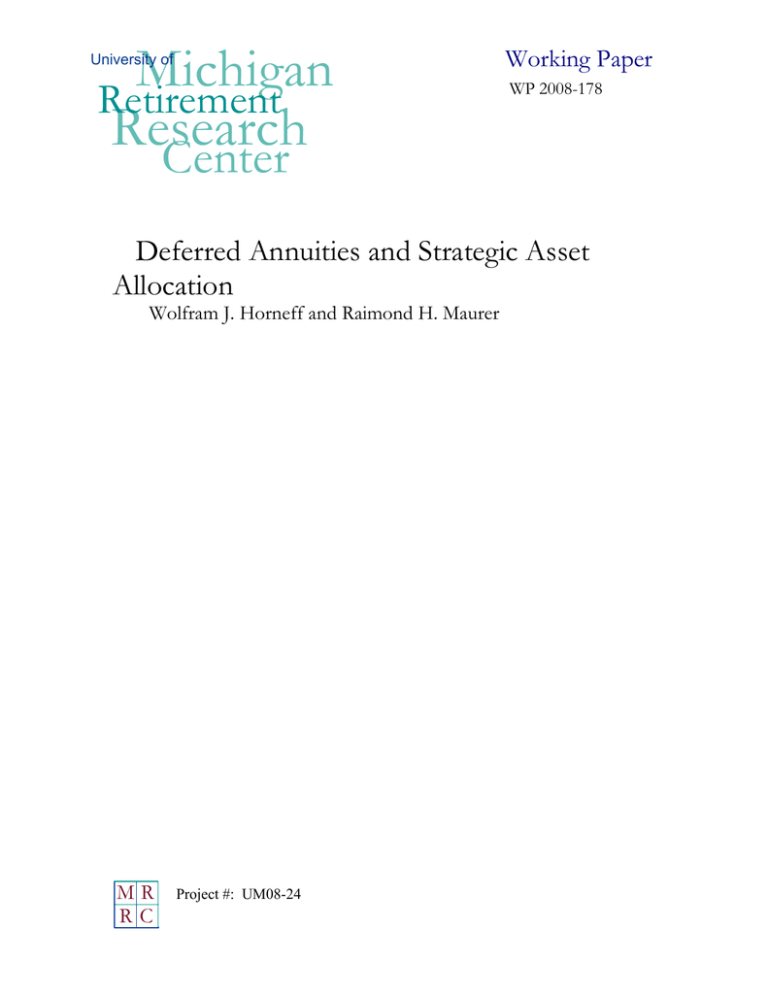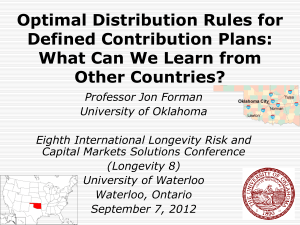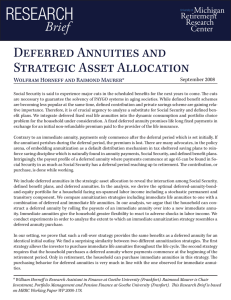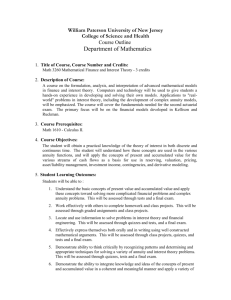
Michigan
Retirement
Research
University of
Working Paper
WP 2008-178
Center
Deferred Annuities and Strategic Asset
Allocation
Wolfram J. Horneff and Raimond H. Maurer
MR
RC
Project #: UM08-24
Deferred Annuities and Strategic Asset Allocation
Wolfram J. Horneff
Goethe University
Raimond H. Maurer
Goethe University
August 2008
Michigan Retirement Research Center
University of Michigan
P.O. Box 1248
Ann Arbor, MI 48104
http://www.mrrc.isr.umich.edu/
(734) 615-0422
Acknowledgements
This work was supported by a grant from the Social Security Administration through the
Michigan Retirement Research Center (Grant # 10-P-98362-5-04). The findings and conclusions
expressed are solely those of the author and do not represent the views of the Social Security
Administration, any agency of the Federal government, or the Michigan Retirement Research
Center.
Regents of the University of Michigan
Julia Donovan Darrow, Ann Arbor; Laurence B. Deitch, Bingham Farms; Olivia P. Maynard, Goodrich; Rebecca
McGowan, Ann Arbor; Andrea Fischer Newman, Ann Arbor; Andrew C. Richner, Grosse Pointe Park; S. Martin
Taylor, Gross Pointe Farms; Katherine E. White, Ann Arbor; Mary Sue Coleman, ex officio
Deferred Annuities and Strategic Asset Allocation
Wolfram J. Horneff and Raimond H. Maurer
Abstract
We derive the optimal portfolio choice and consumption pattern over the lifecycle for
households facing labor income, capital market, and mortality risk. In addition to stocks and
bonds, households also have access to deferred annuities. Deferred annuities offer a hedge
against mortality risk and provide similar benefits as Social Security. We show that a
considerable fraction of wealth should be annuitized to skim the return enhancing mortality
credit. The remaining liquid wealth (stocks and bonds) is used to hedge labor income risk during
work life and to earn the equity premium. We find a marginal difference between a strategy
involving deferred annuities and one where the investor can purchase immediate life annuities.
Authors’ Acknowledgements
Both authors are from the finance department, Goethe University, Grüneburgplatz 1 (House of
Finance), 60323 Frankfurt Germany, email: horneff@finance.uni-frankfurt.de and
Rmaurer@wiwi.uni-frankfurt.de (corresponding), tel.: +496979833647, fax: +496979833900.
This research received support from the US Social Security Administration via the Michigan
Retirement Research Center at the University of Michigan. Additional research support was
provided by the German Investment and Asset Management Association (BVI), Deutscher
Verein für Versicherungswissenschaft, and the Fritz-Thyssen Foundation. Opinions and errors
are solely those of the authors and not of the institutions with whom the authors are affiliated. ©
(2008) Horneff and Maurer. All rights reserved.
1
Introduction and Motivation
With the decline of traditional defined benefit pension plans, defined contribution plans
gained considerable importance for companies around the world in the past two decades.
Defined contribution plans and private saving plans are typically self-managed by households. Arguably, Social Security is said to experience major cuts in the scheduled benefit
payments to guarantee the solvency of the traditional PAYGO system in aging societies.
The literature argues with a dominance criterion for purchasing annuities to finance
consumption (e.g. Yaari 1965 ). Despite this theoretical dominance argument voluntary
annuitization is still limited around the world. There are many advocates of embedding
annuitization as a default mechanism in order to re-enforce withdrawal discipline in tax
sheltered pension accounts that is naturally found in annuity payments, Social Security
and defined benefit schedules. Many times the preferred instrument to implement the
payout and savings discipline is the deferred annuity.
Similar to an immediate annuity, a deferred annuity promises life long payouts in
exchange for an initial non-refundable premium paid to the insurance provider. Contrary to immediate annuities, the contract of a deferred annuity stipulates that the
annuity does not provide any payments until a certain number of years u passed. If the
annuitant perishes during the deferring period, the premium is lost for the annuitant’s
heirs. In fact, a deferred annuity is much cheaper compared to an immediate annuity
with identical payouts because the benefits are deferred until t + u, where t is the age
when the annuities are bought.
While immediate life annuities were recently studied to a large extent by Blake,
Cairns, and Dowd (2003), Horneff, Maurer, and Stamos (2008a,b), Horneff, Maurer,
Mitchell, and Dus (2008), Kingston and Thorp (2005), Koijen, Nijman, and Werker
(2006), Milevsky and Young (2007), Milevsky, Moore, and Young (2006), Yogo (2008),
deferred annuities have not been considered in the dynamic asset allocation of private
1
households so far.
Scott, Watson, and Hu (2008) recommend purchasing deferred annuities in case the
extent to which annuities can be bought is limited. A key assumption of their analysis
constitutes that the initial retirement budget is entirely spent on bonds and so called
’zero coupon annuities’, i.e. contracts with a single payoff in a given year conditional on
the annuitant’s survival. Payoffs of both products are entirely consumed in each period.
Milevsky (2005) analyzes the design as well as the pricing features of real (i.e. where
benefits are adjusted for inflation) deferred annuities. Additionally, he argues that such
products can overcome psychological factors frequently mentioned for explaining the
empirically low levels of voluntary annuitization (also known as the annuity puzzle).
Especially, he pointed out that ”engaging in irreversible financial transactions - that is
annuitization - involving large lump sums will never be appealing to individuals regardless of (whether they grasp) the importance of longevity insurance”. The alternative
would be to buy deferred annuities which are much cheaper than immediate annuities
regardless how important longevity insurance perceived is. This is the alternative which
is seemingly much cheaper than immediate annuities - over a long period of time. We
argue that the household can construct a deferred annuity by rolling over payouts from
immediate annuities (cf. to appendix A). We show that such a roll-over strategy provides the same benefits for the identical initial outlay as a deferred annuity. This is
true whenever the discount factor and the mortality rates to price the annuity are certain. Yet, the household can use the annuity for different purposes than rolling them
over into new immediate annuities. Insofar the annuity with immediate payouts gives
the household greater flexibility to react to adverse developments in the labor income
or in the capital markets, particularly if borrowing on human capital and illiquid life
contingent assets is restricted. Therefore, it would be interesting to study the behavior
as well as the utility loss if the household has only access to deferred life annuities.
2
Albeit, the lack of attention for deferred annuities in the literature, they appear to
be ubiquitous. Intriguingly, the payment structure of deferred annuities is also hidden
within Social Security. Typically employees repeatedly contribute a mandatory fraction of their current labor income to Social Security during their working life. In turn,
contributions are used to fund the payments for beneficiaries currently in retirement.
Beneficiaries receive a certain amount determined by their average past contributions
and working years for as long as they are alive. In fact, Social Security can be considered as an instrument of purchasing deferred annuities repeatedly during working life
because the benefit flow of Social Security closely resembles the payout structure of a
deferred annuity. The same is true for defined benefit plans in which employers make
contributions to fund the pension plan. Later in retirement, the household receives the
payments from the defined pension benefit plan for as long as the head of the household
stays alive.
Social Security and defined benefit plans have a deferral period reaching up to the
beginning of retirement. Therefore, we augment the strategic asset allocation by deferred annuities where payments also start at the beginning of the retirement period
in order to compare the interaction among Social Security, defined benefit plans, and
deferred annuities. Apart from the consumption strategy, we also derive the optimal
equity-bond-annuity portfolio for a CRRA utility maximizing household facing unspanned labor income. In order to better understand the deferral strategy, we augment
the portfolio by immediate annuities as done in Horneff, Maurer, and Stamos (2008).
Then we analyze how closely the underlying annuitization strategy including immediate
annuities resembles a deferral strategy. Both annuitization strategies are compared in
depth to highlight the similarities and differences between them.
In the first section, we discuss the model we apply to find the optimal deferred
annuity demand over life. Here, we discuss preferences, labor income, annuity as well as
3
capital market specifications, wealth accumulation, and our numerical analysis. In the
following chapter, we conduct a Monte Carlo analysis, in order to analyze the expected
life cycle profile as well as the expected asset allocation. We try to identify the difference
between an annuitization strategy when only deferred annuities are involved before
retirement and a strategy with immediate annuities only. A final chapter concludes.
2
2.1
The Model
Preferences
In our study, we employ a time discrete model with t ∈ {0, ..., T + 1}, where t constitutes the investor’s adult age. The adult age is the actual age less 19. We denote pst
as the investor’s subjective probability to survive from t until t + 1. Furthermore, we
assume that the investor’s preferences are given by the CRRA utility function defined
over a single non-durable consumption good. Let Ct be the consumption level at time
t. Then the CRRA preferences can be put in a Bellman equation as:
Vt =
Ct1−ρ
+ βpst Et [Vt+1 ]
1−ρ
(1)
where ρ is the level of relative risk aversion and β is the personal discount factor. Here we
assume that the household does not derive any utility from bequeathing potential heirs.1
Today’s utility is given as the utility from consumption and tomorrow’s discounted
utility from future consumption. We have psT = 0 (1) for the final period. In T
equation (1) boils down to:
VT =
1
CT1−ρ
,
1−ρ
(2)
This can be justified that the household put only that part of financial wealth into the annuity
which is not intended for a bequest, i.e. we only consider that part of wealth which is required for
consumption purchases. Also see Stamos (2008) on this point.
4
which gives us the terminal condition for VT . From the final value, we can work backwards to find the optimal strategies how to consume, invest in bonds, stocks, and how
to purchase deferred annuities.
2.2
Labor Income Process
In order to understand how the illiquidity of deferred annuities affects the overall asset
allocation, we model transitory and permanent income shocks. Previous literature on
strategic asset allocation such as Bodie, Merton, and Samuelson (1992), Cocco, Gomes
and Maenhout (2005), Heaton and Lucas (1997), and Viceira (2001) highlighted the
relevance of considering unspanned labor income when analyzing the strategic asset
allocation decisions of households. The labor income Yt is given by:
Yt = exp(f (t))Pt Ut ,
(3)
Pt = Pt−1 Nt ,
(4)
where f (t) is used to recover the hump shape of the empirically observed income profile
over time t. Here, Pt is a permanent component with innovation Nt . Ut is a transitory
shock. The logarithms of both Nt and Ut are normally distributed with means zero and
with volatilities σN , σU , respectively. The shocks are assumed to be uncorrelated. In
retirement (t ≥ K), we assume for the sake of simplicity that the individual receives
constant pension payments Yt = ζ exp(f (K))PK , where ζ is the constant replacement
ratio.
2.3
Annuity and Capital Markets
The household can directly invest in two financial assets: riskless bonds and risky stocks.
The real bond gross return is given by Rf , while the real risky stock return in t is Rt .
5
The risky return is log-normally distributed with an expected return µ and volatility
σs . Let φn (φu ) denote the correlation between the stock returns and the permanent
(transitory) income shocks.
In our model, the household can also purchase deferred constant real payout life
annuities before retirement and immediate annuities with constant payouts during the
retirement period. In our analysis, a life annuity is a financial contract between an
individual and an insurer ”that pays out a periodic amount for as long as the annuitant
is alive, in exchange for an initial premium” (Brown et al., 2001). During the working
life, the life annuity does not pay out until the investor reaches the retirement age K,
even though the premium is possibly exchanged years before the end of the investor’s
working life.
The illiquidity related to deferred annuities adversely affects the investor’s ability
to react to either adverse developments of labor income or sudden declines in the stock
market. In return for the illiquidity, the household gains a spread over the typical bond
investment. The spread comes about because the funds of those who die in the annuity
pool are distributed among the living members of a cohort. The literature refers to
this attribute of annuities as the mortality credit. Therefore, a deferred annuity simply
constitutes a separate asset class with distinctive risk and return characteristics. We
treat the purchase of deferred annuities as a portfolio choice problem by putting them
on an equal footing with equity and bond investments. In the remainder, we model
the annuitization decision essentially in a dynamic portfolio choice framework akin to
Horneff, Maurer, and Stamos (2008).
The actuarial premium At of a deferred life annuity with payments L starting in K is
different from the life annuity payments within the retirement period. During working
life, the household can only purchase deferred annuities where payments commence
only at retirement. In retirement, the household can buy immediate annuities, where
6
payments start from the next period onwards. Lt denotes the payouts from immediate
annuities because we allow the household to also purchase immediate life annuities in
retirement (i.e. from age K onwards).
At =
LK ht , t < K,
Lt ht ,
(5)
t≥K
where ht is the annuity factor for an individual with adult age t. The annuity factor
during the working life is essentially the pricing equation for deferred annuities with
payments starting at the beginning of the retirement period.
ht = (1 + δ)
K−2
Y
!
−(K−1−t)
pau Rf
u=t
TX
−K
K−1+s
Y
s=1
u=K−1
!
pau Rf−s
t<K
(6)
where pau are the survival probabilities used by the life annuity provider and δ is the
loading factor. In turn, the annuity factor is the loading factor times the deferral
discount factor times the sum of the discounted expected payouts. In retirement, the
household can also purchase immediate annuities. The annuity factor reduces to:
ht = (1 + δ)
T −t
t+s
X
Y
s=1
!
pau Rf−s ,
t≥K
(7)
u=t
In general, insurers use survival probabilities pau that are higher than the average
population survival probabilities psu . The additional price increment is thought of as a
compensation for both the adverse selection going on in annuity markets (Brugiavini,
1993, Finkelstein and Poterba, 2004) and the macro longevity risk (Cairns, Blake, and
Dowd, 2006b). Adverse selection in annuity markets arises because heads of households
who believe themselves to be healthier than average are more likely to buy annuities.
Macro longevity risk refers to the risk of changing mortality probabilities. Administra-
7
tion costs to organize the pool are covered by the loading factor δ. We assume zero
loads and no asymmetries in mortality beliefs except for the welfare analysis where we
introduce a loading factor.
We only consider highly incomplete annuity markets inasmuch only deferred annuities with life long payouts are available during working life and funds underlying the
annuity are totally invested in bonds. We do not account for annuities which payout
at only one specific age and state (as in the complete markets case in Davidoff, Brown,
and Diamond, 2005). Due to adverse selection issues and market incompleteness such
Arrow Debreu annuities do not exist. (see Yagi and Nishigaki (1993))
2.4
Wealth Accumulation
At the beginning of every period, the utility maximizing household under consideration
can decide on how to spread wealth on hand Wt across bonds Mt , stocks St , new
annuities purchases At , and consumption Ct . Therefore, the budget constraint is
Wt = Mt + St + At + Ct ,
(8)
where we refer to Mt + St as the value of financial wealth. The individual’s disposable
wealth on hand in t + 1 is given by
Wt+1
Mt Rf + St Rt+1 + Yt+1
t<K
Mt Rf + St Rt+1 + Lt+1 + Yt+1
t ≥ K,
(9)
where Mt Rf + St Rt+1 denotes the next period value of financial wealth, Lt+1 is the sum
of annuity income which the investor gets from all previously purchased annuities and
Yt+1 is the labor income. The state variable LK records the claims of accessing annuity
payouts at adult age K inasmuch deferred payments start at this age. Whereas the
8
state variable Lt after age K denotes the sum of payouts from previously purchased
immediate and deferred annuities. Note that the sum of claims to annuity payouts and
the sum of annuity payments follow the processes:
{t+1}
LK
{t}
= LK + At /ht t < K
(10)
Lt+1 = Lt + At /ht t ≥ K
where LK is the sum of all annuity payments from annuities purchased before K and
At /ht is the annuity payment purchased in t. In t + 1 the investor has to make a new
decision on how to spread wealth on hand Wt+1 across bonds, stocks, annuities, and
consumption. We prevent households from borrowing against human capital and from
selling annuities. Both restrictions are binding because otherwise households would
engage in highly leveraged stock positions financed by short positions in bonds and/or
annuities in order to compensate the over-investment in human capital at young ages.
Thus each year the optimal policy has to satisfy:
Mt , St , At ≥ 0.
2.5
(11)
Numerical Method and Calibration
Optimization problems of this type cannot be solved analytically due to the untradeable
labor income, the irreversibility of annuity purchases, and the shortselling restrictions.
Therefore we adopt the standard approach of dynamic stochastic programming to solve
the household’s optimization problem. The household maximizes (1) under budget and
short-selling restrictions (8),(9), and (11), whereby the choice variables in each year the
household is alive are the demand for stocks St , bonds Mt , new life annuities At , and
consumption Ct . The optimal policy depends on four state variables: the permanent
income level Pt , wealth on hand Wt , annuity payouts from previously purchased an9
nuities Lt , and age t. First of all, the curse of dimensionality (Bellman, 1961) can be
partly mitigated by reducing the state space by one state variable as we exploit the scale
independence of the optimal policy if we rewrite all variables using lower-case letters
as ratios of the permanent income component Pt (see for example Cocco, Gomes, and
Maenhout, 2005). We solve the problem in a three-dimensional state space by backward
induction. The continuous state variables normalized wealth w and normalized annuity
payouts l have to be discretized and the only discrete state variable is age t. The size
of the grid is 40(w)x40(l)x81(t). The grid we use is equally spaced for the logarithms
of w and l since the policy functions and value function are especially sensitive in the
area with low w or l. For each grid point we calculate the optimal policy and the size
of the value function.
To provide numerical insight into our setup, we calibrate the stylized case as follows:
The starting age is set to 20, the retirement age to 65 (K = 46), and the maximum
age to 100 (T = 81). In addition, we also study the case when annuity payouts start
only at age 85. The preference parameters are set to standard values found in the lifecycle literature (e.g. Gomes and Michaelides, 2005): coefficient of relative risk aversion
ρ = 5 and the personal discount factor β = 0.96. Applying nonlinear least squares
we fit the Gompertz force of mortality to the 2000 Population Basic mortality table
for US females. We use them for pricing the annuities and for evaluating the utility
from consumption. The deterministic age-dependent labor income function f (t) for
individuals with high school education excluding college education and the replacement
ratio ζ = 0.68 are taken from Cocco, Gomes, and Maenhout (2005). Our volatility
parameters σu = 0.15 and σn = 0.1 are in line with the estimates found by Gourinchas
and Parker (2002). Furthermore, we select a real interest rate Rf of 2 percent, an
equity premium µ − Rf of 4 percent, and a stock volatility σ of 18 percent. We choose
correlations between the stock returns and the transitory (permanent) income shocks
10
of φn = 0 (φu = 0).
3
3.1
Optimal Annuity Demand
Deferred Life Annuities
In this section, we analyze the simulated distributions of the relevant choice and state
variables by conducting an extensive Monte Carlo analysis based on the optimal feedback controls we obtained from solving the Bellman equation under the shortselling
restrictions (see appendix B) Drawing 50,000 independent stochastic scenarios, we first
compute the expected life cycle profile for our stylized case with risky labor income as
the inclined reader can infer from figure (1). Graph A shows that the household starts
purchasing deferred annuities from age 38 on in expectation and continues until the
retirement before turning to immediate annuities in our analysis. If deferred annuities
are purchased as early as 38, the household is willing to wait at least 27 years before
the annuity starts paying off. After entering retirement, the household further buys
immediate life annuities. The liquid savings of the household peak at 55 when savings
are 5.5 times the average labor income. When the household turns 77, all liquid savings are exhausted. After the age 77, the household uses both the current pension and
annuity income to bet on survival by purchasing more immediate annuities. Expected
consumption increases because the household is not able to borrow against both the
annuity and future pension income. Turning to the expected asset allocation, we find
the typical life cycle profile as the overall equity exposure is successively reduced in
favor of deferred annuities. Initially, the equity exposure is high to counterbalance the
implicit holdings in human capital. Over time the value of human capital shrinks and
the mortality credit of deferred annuities surges. In turn, annuities crowd out the equity exposure of the household. Bonds only play a miniscule role in the asset allocation
11
Graph (A) Expected Life Cycle
Graph (B) Expected Portfolio Weights
12
1
Consumption
Annuity Payment
Salary
Annuity Purchases
Sum of Savings
0.9
Bonds
0.8
Deferred Annuities
0.7
8
Fraction
C, A, Y, L, M+S
10
6
0.6
Stocks
0.5
0.4
4
0.3
0.2
2
0.1
0
20
30
40
50
60
Age
70
80
90
0
20
100
30
40
50
60
Age
70
80
90
100
Figure 1: Expected Life Cycle and Asset Allocation: Graph (A) shows the expected
Life Cycle profile in terms of consumption, new annuity purchases, liquid savings, sum
of annuity payouts, and labor as well as retirement income. Graph (B) depicts the
expected asset allocation of the household over the life-cycle. In our analysis, we assume
a female with maximum life-span age 20 - 100, no loads for annuities, no mortality
asymmetries, ρ = 5, income is stochastic. We calculate the expectations by resorting
to 50,000 Monte-Carlo simulations using the optimal policies derived by solving the
Bellman equation. When computing the expected portfolio weights we determine the
value of annuity wealth as the actuarial present value of payouts from all previously
purchased annuities.
because they are dominated by the mortality-credit enhanced deferred annuities early
on. The only reason for the household to have some bond exposure is to rebalance the
portfolio quickly after a sharp drop within the investment portfolio.
3.2
Roll-over Features of Immediate Life Annuities
In this section, we analyze to what extent immediate annuity purchases resemble a
deferring strategy over the life cycle. To do so, we have to modify two transition
equations to account for immediate payout annuities during working life. The state
variables develop as follows:
Lt+1 = Lt + At /ht
12
(12)
where the annuity factor is simply computed as:
ht = (1 + δ)
T −t
t+s
X
Y
s=1
!
pau Rf−s ,
(13)
u=t
The annuity factor is the expected sum of discounted annuity payouts. We also
have to make sure that the household receives immediate payouts in the next period,
therefore we have to change the cash on hand during the working life period.
Wt+1 = Mt Rf + St Rt+1 + Lt+1 + Yt+1
(14)
In order to analyze how frequently a deferred annuity is constructed or partly
resembled through the ongoing purchase of immediate life annuities, we first derive
the optimal feedback controls for purchasing immediate annuities over the life cycle.
After obtaining the new annuity dynamics, we conduct a Monte Carlo analysis with
50,000 iterations. Now we consider on each of the life cycle paths how many times
a household rolls the annuity payout over into a new annuity purchase. To do so,
we compute the payouts Lt from previously purchased annuities and compare them
to the amount of new annuity purchases At . Whenever Lt < At we know that all
payouts are rolled over to a new annuity in that given year. Using this specification, we
compute for each household the maximum number of successive roll-over years. Figure
(2) provides the distribution of the maximum roll-over years. Hereby, graph (A) reports
the result for the case when labor income is certain. The average time of a continued
roll-over strategy is 7.6 years while the most frequent maximum roll-over is seven years.
Therefore, a typical household with certain labor income buys immediate annuities for
seven successive years by spending at least as much cash on hand as available from
annuity payouts.
As graph (B) in figure (2) shows: if the household faces uninsurable stochastic labor
13
Graph (A) Certain Labor Income
Graph (B) Risky Labor Income
80 %
24 %
70 %
7.6 = Mean
1.2 = STD
3.1 = Skewness
7.0 = Q−50%
8.0 = Q−75%
7.0 = Q−25%
60 %
5.8 = Mean
2.0 = STD
1.2 = Skewness
5.0 = Q−50%
7.0 = Q−75%
4.0 = Q−25%
16 %
Frequency
Frequency
50 %
20 %
40 %
12 %
30 %
8%
20 %
4%
10 %
0
0
5
10
15
Maximum Years of Roll Over
20
0
25
0
5
10
15
Maximum Years of Roll Over
20
25
Figure 2: Maximum Years of Roll-Over: Graph (A) shows the case with certain labor
income. Graph (B) depicts the case with risky labor income. Maximum years of
roll-over means the number of successive years in which the payouts from annuities
cannot fully cover the new annuity purchases. In our analysis, we assume a female
with maximum life-span age 20 - 100, no loads for annuities, no mortality asymmetries,
ρ = 5. We calculate 50.000 different life-cycles by using the optimal policies derived by
the maximization of the Bellman equation under constraints.
income, the distribution is moved to the left hand side (mean 5.8) and shows a much
higher variability (2.0). This can be explained by the fact that the household requires
more flexibility to use the payouts from annuities in a different way.
While the previous analysis considered all life-cycles pathwise, the following breakdown looks at percentage of a roll-over strategy per year across all households. Again,
we consider the simulated paths based on the optimal strategy with immediate annuities. Contrary to the previous analysis, we compare the probability of rolling the
annuity payouts over into new life annuity purchases in a cross section analysis by considering all households at a certain point in time. The results are displayed in figure
(3). As one can infer from graph (A), the roll-over strategy is done in most cases early
on. However, only few households voluntarily annuitize at this stage of their life cycle,
especially if labor income is certain. So the percentage term might not be as representative as other figures in our analysis. Here, the percentage of roll-over strategies seldom
drops below 50 percent before retirement starts. In the case of risky labor income, the
14
Graph (B) Risky Labor Income
1
0.9
0.9
0.8
0.8
0.7
0.7
Percentage L<A
Percentage L<A
Graph (A) Certain Labor Income
1
0.6
0.5
0.4
0.6
0.5
0.4
0.3
0.3
0.2
0.2
0.1
0.1
0
20
30
40
50
60
Age
70
80
90
0
20
100
30
40
50
60
Age
70
80
90
100
Figure 3: Percentage of Roll-Over: Graph (A) shows the case with certain labor income.
Graph (B) depicts the case with risky labor income. In our analysis, we assume a female
with maximum life-span age 20 - 100, no loads for annuities, no mortality asymmetries,
ρ = 5. We calculate 50.000 different life-cycles by using the optimal policies derived by
the maximization of the Bellman equation under constraints.
roll-over strategies are less likely since the household has to rebalance the portfolio and
buffer adverse career developments.
3.3
Deferred vs. Immediate Life Annuities
In this section, we compare the purchasing behavior of households as far as deferred
and immediate life annuities are concerned. First, we analyze the expected new annuity
purchases over the life cycle for the case with certain labor income. The results are
reported in Graph A of figure (4). The household uses more cash on hand to purchase
immediate than deferred life annuities. The discrepancy among all three strategies
reaches its largest point at age 60. While the difference for all annuity strategies is
moderate in case of certain labor income, the difference becomes even more pronounced
in case the labor income is risky. Again, the greatest discrepancy between the deferring
and the annuitization strategy peaks at age 60. The following analysis considers the
welfare loss of having only access to deferred annuities as compared to immediate ones.
15
Graph (A) Certain Labor Income
Graph (B) Risky Labor Income
1.4
Deferred 85
Deferred 65
Immediate Annuities
1
0.8
0.6
0.4
0.2
0
20
Deferred 85
Deferred 65
Immediate Annuities
1.2
A as multiple of initial income
A as multiple of initial income
1.2
1
0.8
0.6
0.4
0.2
30
40
50
60
Age
70
80
90
0
20
100
30
40
50
60
70
80
90
100
Figure 4: Expected Spending on New Annuities: Graph (A) shows the case with certain
labor income. Graph (B) depicts the case with risky labor income. In our analysis,
we assume a female with maximum life-span age 20 - 100, no loads for annuities, no
mortality asymmetries, ρ = 5. We calculate 50,000 different life-cycles by using the
optimal policies derived by the maximization of the Bellman equation under constraints.
In our welfare analysis, we also consider cases where we include explicit loads of
δ = 2.38. In addition, we assume a difference in mortality beliefs by using an annuity mortality table for pricing the life annuities. Welfare gains are computed as the
additional constant life long income (as a fraction of average labor income) an individual without access to deferred and immediate annuity markets would need in order to
attain the same expected utility as in the case with annuity markets. The numerical
computations are done for age 20. Then we compute the marginal welfare loss of having
only access to deferred annuities as compared to immediate annuities by calculating the
difference in the additional consumption stream between the deferred and the immediate annuitization strategy. The actual difference in the additional life long income
stream is displayed in the following summarizing table.
The welfare loss of having only access to deferred annuities starting at age 65
as compared to immediate annuities is small at 1 bp difference in the case without
any loadings. The welfare difference for an annuity starting paying off at age 85 is
bigger with 51 bp. If we add initial loadings to our analysis, deferred annuities become
16
Welfare Gains at Age 20
Deferred 65
Deferred 85
-1 bp
+1 bp
-51 bp
-18 bp
> -1 bp
+1 bp
-28 bp
-3 bp
Risky Labor Income
Without Loads
With Loads
Riskless Labor Income
Without Loads
With Loads
Table 1: This table reports welfare gains in the presence of annuity markets for all cases
considered previously. Welfare gains are computed as the additional constant life-long
income (as a fraction of average labor income) at age 20 an individual without access
to annuity markets would need in order to attain the same expected utility as in the
case with annuity markets. Then we compute the additional welfare loss of having
only access to deferred annuities as compared to immediate annuities. This is done by
computing the difference in the additional consumption stream between the deferred
and the immediate annuitization strategy. The numerical computations are done for
deferred annuities where payouts start either at age 65 or at age 85.
preferable to a small extent in as much the household has to bear the costs of rolling
the annuity payouts over in each period. When dropping the riskiness of labor income,
the difference to immediate annuities becomes even smaller. While in the case with
risky labor income, immediate payouts are an important cash flow whenever the labor
income and the stock market decline, the utility loss in the certain labor income case
is smaller due to the lack of uncertainty generated by income fluctuations. As we have
seen in the previous section, the household rolls the payouts over more often if income
is certain.
4
Conclusion and Discussion
In this study, we derive the optimal deferred-annuity-bond-equity portfolio of a household facing unspanned labor income. We compare the resulting annuitization to the
17
one with immediate annuities. We find an astonishing similarity between the two different annuitization strategies. The purchasing behavior of deferred annuities is very
much in line with the one observed in the previous literature, which analyzes the annuitization strategy with immediate annuities. Even though the household purchases
less deferred annuities than immediate annuities in expectation, the life cycle profiles
and the expected asset allocations are virtually the same. Furthermore, we find that
households having only access to immediate annuities engage in a roll-over strategy
mimicking deferred annuities to a considerable extent. The roll-over strategy is less
pronounced if the household faces risky labor income as compared to certain labor
income. A welfare comparison indicates a small difference between immediate and deferred annuitization, particularly for the case where annuity payouts commence at age
65. Deferred annuities might become more appealing in relative terms to immediate,
if loading is considerably high. Since deferred annuities are less capital intensive than
immediate annuities, they might be a good instrument to overcome the reluctance to
engage in irreversible financial transactions such as annuitization early in life.
18
Appendix A: Rollover vs. Deferred Strategy
We argue that a roll-over strategy using annuities with immediate payouts leads - with
identical cash flows - to the same payout as the purchase of a deferred annuity. Here
we consider two intervals: period 1 and period 2. The investor can decide between a
deferred annuity and a roll-over strategy using immediate annuities. Furthermore, p1
denotes the probability of surviving the first period from time 0 to 1, while p2 is the
probability of surviving the second period from time 1 to 2. The discount rate r is
constant, the loading factor is λ, and the resulting price for the annuity is X. The
payout LD
2 in the second period for a deferred annuity is:
X=
LD p1 p2
λ
r2
LD
2 =
Xr2
p1 p2 λ
(15)
In the case of an immediate annuity with payments LI1 in period 1 and of gLI1 in
period 2, the premium is given by (g is the escalating factor g > 0):
X = ( L1rp1 +
LI1 =
L1 gp1 p2
)λ
r2
(16)
Xr
(p1 +
gp1 p2
)λ
r
Now the investor uses the proceeds LI1 from the immediate annuity to purchase an another annuity. The additional payouts in period 2 from this annuity is given by LI2 :
LI2 =
r
Xr
gp p
λ2 (p1 + 1r 2 ) p2
19
(17)
The resulting sum of the payouts from the previous annuity and the current annuity purchased in period 2 is LIcum = gLI1 + LI2 and can be rewritten as:
LIcum =
=
Xrg
gp p
λ(p1 + 1r 2 )
Xr2
(g
λ(p1 r+gp1 p2 )
+
+
Xr
r
gp p
λ2 (p1 + 1r 2 ) p2
(18)
r
)
λp2
Now, we can check the condition that the cumulative payouts from the roll-over strategy
with immediate annuities are identical to the payments of the deferred annuity:
LIcum = LD
2 ⇔
Xr2
(g
λ(p1 r+gp1 p2 )
+
r
)
λp2
=
Xr2
λp1 p2
⇔
r
gp2 + λ
gp2 +r
=1
(19)
This condition is fulfilled in the case of a loading factor equal to one, λ = 1, i.e. if
the annuities are actuarially fairly priced. In case λ > 1 the resulting payoffs from the
roll-over strategy is lower compared to the deferred annuity strategy.
20
Appendix B: Numerical Integration and Optimal Annuitization Policy
For computing the value function, we have to solve the multiple integral. Thereby, the
(multiple) integrals of the expectation term in:
RRR
1−ρ
1−ρ
(pst vt+1
+ (1 − pst )kb1−ρ
t+1 )Nt+1 ·ϕ(Nt+1 , Ut+1 , Rt+1 )dNt+1 dUt+1 dRt+1
R s 1−ρ
1−ρ
) ϕ(Rt+1 ) dRt+1
(pt vt+1 + (1 − pst )kbt+1
t<K
t ≥ K,
(20)
with ϕ(.) denoting the (multivariate) probability density function of the log-normal
distribution is computed by resorting to gaussian quadrature integration and the optimization is done by numerical constrained maximization routines. The values of the
policy functions and value function lying between the grid points are computed by
cubic-splines interpolation. The optimal annuitization policy is displayed in the graph
below.
21
Annuity Demand (a)
1000
500
0
1000
800
100
600
80
400
60
200
Wealth on Hand (w)
40
0
20
Age
Figure 5: Annuity Policy: Graph shows annuity policy with risky labor income. Until age 65 with household purchases deferred annuities with payouts starting at age
65. Later, the household purchases immediate annuities. In our analysis, we assume
a female with maximum life-span age 20 - 100, no loads for annuities, no mortality
asymmetries, ρ = 5, where L is set to zero.
22
References
Bellman, R., 1961, Adaptive Control Processes: A Guided Tour, Princeton University
Press, Princeton, New Jersey.
Blake, D., A. Cairns, and K. Dowd, 2003, “Pension Metrics 2: Stochastic Pension Plan
Design during the Distribution Phase,” Insurance: Mathematics and Economics, 33
(1), 29–47.
Bodie, Z., R. Merton, and W. Samuelson, 1992, “Labor supply flexibility and portfolio
choice in a life cycle model,” Journal of Economic Dynamics and Control, 16, 427–
449.
Brown, J., O. Mitchell, J. Poterba, and M. Warshawsky, 2001, The Role of Annuity
Markets in Financing Retirement, MIT Press, Cambridge, M.A.
Brugiavini, A., 1993, “Uncertainty Resolution and the Timing of Annuity Purchases,”
Journal of Public Economics, 50 (1), 31–62.
Cairns, A., D. Blake, and K. Dowd, 2006b, “Pricing Death: Frameworks for the Valuation and Securitization of Mortality Risk,” ASTIN Bulletin, 36, 79–120.
Cocco, J., 2005, “Portfolio Choice in the Presence of Housing,” The Review of Financial
Studies, 112, 61–156.
Cocco, J., F. Gomes, and P. Maenhout, 2005, “Consumption and Portfolio Choice over
the Life Cycle,” The Review of Financial Studies, 18, 491–533.
Finkelstein, A., and J. Poterba, 2004, “Adverse Selection in Insurance Markets: Policyholder Evidence from the U.K. Annuity Market,” Journal of Political Economy,
112, 183–208.
23
Gomes, F., and A. Michaelides, 2005, “Optimal Life-Cycle Asset Allocation: Understanding the Empirical Evidence,” Journal of Finance, 60, 869–904.
Gourinchas, P.-O., and J. A. Parker, 2002, “Consumption over the Life Cycle,” Econometrica, 70, 47–89.
Heaton, J., and D. Lucas, 1997, “Market Frictions, Savings and Portfolio Choice,”
Macroeconomic Dynamics, 1, 76–101.
Horneff, W., R. Maurer, O. Mitchell, and I. Dus, 2008, “Following the Rules: Integrating Asset Allocation and Annuitization in Retirement Portfolios,” Insurance:
Mathematics and Economics, 42, 396–408.
Horneff, W., R. Maurer, and M. Stamos, 2008a, “Life-Cycle Asset Allocation with
Annuity Markets,” Journal of Economic Dynamics and Control, accepted, 2008.
Horneff, W., R. Maurer, and M. Stamos, 2008b, “Optimal Gradual Annuitization:
Quantifying the Costs of Switching to Annuities,” The Journal of Risk and Insurance,
in press, 2008.
Kingston, G., and S. Thorp, 2005, “Annuitization and Asset Allocation with HARA
Utility,” Journal of Pension Economics and Finance, 4, 225–248.
Koijen, R., T. Nijman, and B. Werker, 2006, “Dynamic Asset Allocation with Annuity
Risk,” Discussion paper, Tilburg University - Center for Economic Research.
Milevsky, M., 2005, “Real Longevity Insurance with a Deductible: Introduction to
Advanced-Life Delayed Annuities (ALDA),” North American Actuarial Journal, Vol.
9, No. 4 (October), 109–122.
24
Milevsky, M., K. Moore, and V. Young, 2006, “Asset Allocation and Annuity-Purchase
Strategies to Minimize The Probability of Financial Ruin,” Mathematical Finance,
16, 647–671.
Milevsky, M., and V. Young, 2007, “Annuitization and Asset Allocation,” Journal of
Economic Dynamics and Control, 31, 3138–3177.
Scott, J., 2008, “The Longevity Annuity: An Annuity for Everyone?,” Financial Analyst
Journal, 64(1), 40–48.
Stamos, M. Z., 2008, “Optimal Consumption and Portfolio Choice for Pooled Annuity
Funds,” Insurance: Mathematics and Economics, 43, 56–68.
Viceira, L., 2001, “Optimal Portfolio Choice for Long-Horizon Investors with Nontradable Labor Income.,” Journal of Finance, 56 (2), 433–470.
Yaari, M., 1965, “Uncertain Lifetime, Life Insurance, and the Theory of the Consumer,”
Review of Economic Studies, 32, 137–150.
Yagi, T., and Y. Nishigaki, 1993, “The inefficiency of Private Constant Annuities,” The
Journal of Risk and Insurance, 60 (3), 385–412.
Yogo, M., 2008, “Portfolio Choice in Retirement: Health Risk and the Demand for
Annuities, Housing, and Risky Assets,” Discussion paper, Wharton School.
25









